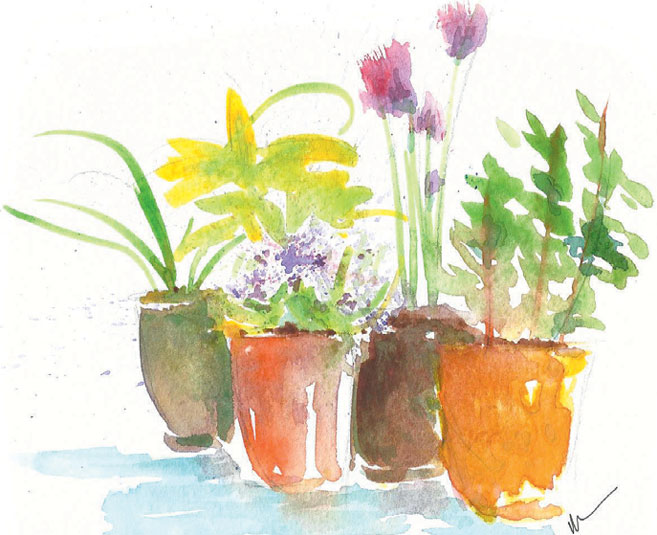Favorite Culinary Herbs for the Kitchen Garden
No other ingredients transform a meal more easily than fresh herbs, adding color, texture and flavor without packing on fat and calories. Especially well suited to container gardening, herbs are an ideal project particularly for those new to gardening.
Since they do not require a lot of maintenance or specialized care, herbs are forgiving in Oklahoma’s unpredictable climate. Remembering a few basic guidelines will encourage success for anyone creating their own culinary herb garden.
First, consider the location for your garden. Will you create your garden in patio containers or in a raised bed? Most herbs do not require a lot of fertilizer and they enjoy well-drained locations. Learning to nurture the soil first will build healthier plants, eliminate pests and provide nutrition for new seedlings. In short, if your soil is healthy, your garden will be, too. Whether you choose containers, raised bed or a traditional garden space, add and amend the soil so that new plantings get the best start.
When shopping for soil for your new garden learn to read the N-P-K label on soil packaging. This label details the nitrogen (N), phosphorus (P) and potassium (K) levels in the product. Since a high nitrogen level discourages fruiting, a lower nitrogen level (under 6%) is better for edible gardening. And while some people enjoy using compost, it can often be unbalanced in nutritional health. Using compost around established seedlings is a better course of action.
A location near the cooking area is best, making patios a perfect place for herbs. However, if you are using containers, remember that they will require 30% more water than a raised bed or traditional garden. Be willing to water more in the hot days of Oklahoma summer and don’t forget to water in the winter! Oklahoma’s winter winds will threaten the healthiest of plants and a good rule is to water just prior to a freeze as moist soil actually protects roots from frost.
Most herbs are easier to grow from cuttings than from seeds. Some, like cilantro and dill, do not transplant well so start those with seeds, following the directions on the seed packet.
Perhaps the biggest threat to a new garden is the discouragement that can set in when daily maintenance such as watering, weeding and harvesting becomes task-heavy, so start small! A container garden with three to five herbs, successfully grown, will encourage you to grow more in upcoming seasons. Gardening should be fun, so grow with your garden and enjoy your progress.
Every gardener deserves the luxury of growing rosemary. Its name originates from the Latin for “mist of the sea,” apt for its ancient use in Mediterranean gardens. An evergreen in Green Country (be sure to water throughout the cold winters, though!), rosemary also attracts bees and takes the heat well. Remember, rosemary can grow up to five feet in diameter and height, so make sure it has plenty of room to spread its fragrant stems.
The many forms of basil allow for variety and experimentation. Common sweet basil is a familiar favorite with Italian cuisine but did you know that growing tomatoes alongside basil creates tastier tomatoes? Try a container of three types of basil: sweet basil, spicy globe basil and Thai basil for a beautiful, flavorful container garden. Thai basil (sometimes called cinnamon basil), with its deep purple blooms and spicy licorice scent, is a chef favorite. Basil enjoys hot weather and flavor is best when the leaves are harvested before basil “bolts” (or produces flowers).
From French Creole to Caribbean jerk seasoning, few herbs offer the versatility of thyme. Its name means “joy of the mountain,” which conjures images from its Mediterranean past. Like rosemary, it enjoys warmer temperatures but with adequate winter watering it can over winter, making it perfect to snip on cold days for winter stews. Much easier to grow from cuttings, experiment with its various varieties such as lemon thyme and use it as a ground cover in your raised beds or let it tumble over the sides of containers.
Oregano is another herb that makes a fragrant and flavorful ground cover. Moreover, it can overwinter as an evergreen. It thrives around basil and enjoys the heat. Try adding it to containers, even those with perennials, and watch how it spills over the side in a lovely cascade. Snipping fresh oregano for summer eating also trims up the plant, keeping it neat, tidy and productive.
Dill is one herb that is best started from seed, spaced 18 inches a part in about 1/4 inch soil. It needs a richer soil and doesn’t care for wind or heat, making it a perfect herb to grow in early spring or late summer for a fall harvest. Because of its sensitivity to other herbs and plants, dill is more easily grown in containers that can be protected from harsh winds and colder temperatures. If you do use it in your raised bed, plant it towards the back with plenty of room for it to reseed.
Borage might be new to some gardeners but its value to the herb garden is significant. First, its lovely lavender blossoms can bring pollinators, butterflies—and other admirers—to your edible garden. Careful, those tiny cuttings grow into large (up to five feet) plants, so make sure you plant with plenty of container depth (12 inches or more) or in an area where it can spread out in the raised bed. The flowers, with their cucumber-like flavor, can be used in drink and are lovely as a pastry décor. Use the leaves and stems in salads and stews. Borage, an annual in our climate, is easily started from seeds and make a distinctive presence in any edible garden.
Despite its association with spicy foods, cilantro is a cool-weather herb, best grown in Oklahoma late spring or in the fall. If left to mature, it puts forth coriander seeds. When the plant begins to turn brown, cut the seed heads, put them in a paper bag and hang the bag in a clean, dry location. The seeds will find their way to the bottom of the bag, making them easy for cooking, storage or for replanting in your garden.
The delicate taste of chives is another culinary delight and, like cilantro, chives enjoy cooler temperatures. Perfectly paired with rosemary in the garden, chives thrive with consistent watering until well rooted. Snip the plant as needed for your recipes and though the flowers are attractive, the plant will produce more when those are discouraged through deadheading (or pinching off the flowers).
With its long history of both culinary and medicinal uses, sage is a gardener favorite. Perfect for hot days and dry soil, sage is an herb garden must-have. Best grown from starting plants, sage can thrive year round when it receives adequate water and protection from strong winds.
No garden is really complete without parsley. Start with seedlings or cuttings. Sought after by swallowtail butterflies as host plant for their larvae, bees and other nectar-feeding insects enjoy its flowers. Several varieties exist: try flat-leaved or Italian parsley, depending on your recipes. Parsley is an annual in Oklahoma gardens, needing to be replanted each year.
A culinary herb garden is a sensory adventure that adds so much to everyday dishes and adds panache to special occasion menus. Low maintenance, herbs can be just the beginning for edible gardening enjoyment and will take your recipes to a new aromatic and flavorful level.




